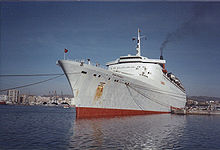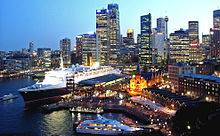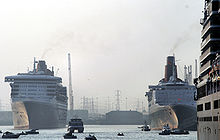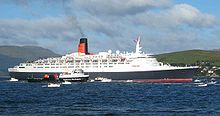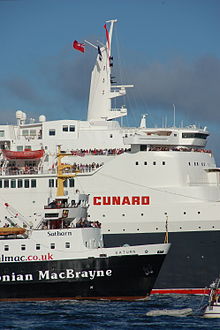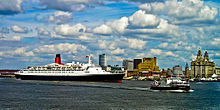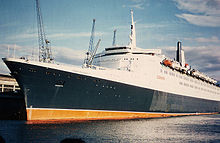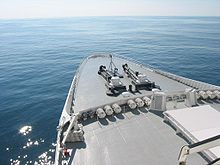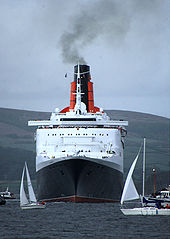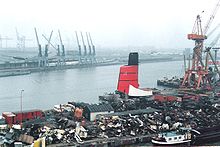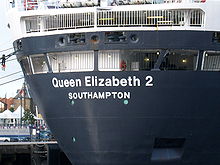
Queen Elizabeth 2
Did you know...
SOS Children made this Wikipedia selection alongside other schools resources. A quick link for child sponsorship is http://www.sponsor-a-child.org.uk/
 Queen Elizabeth 2 at Trondheim. |
|
| Career | |
|---|---|
| Name: | Queen Elizabeth 2 |
| Owner: | 1968-2008: Cunard Line Ltd 2008- now: Istithmar, Dubai |
| Port of registry: | 1968-2009: 2009- now: |
| Route: | North Atlantic and Cruising during Cunard service |
| Ordered: | 1964 |
| Builder: | John Brown and Company ( Upper Clyde Shipbuilders), Clydebank, Scotland |
| Cost: | £29,091,000 (£419 million as of 2013) |
| Yard number: | 736 |
| Laid down: | 5 July 1965 |
| Launched: | 20 September 1967 |
| Christened: | 20 September 1967 by Queen Elizabeth II |
| Completed: | 26 November 1968 (Sea trials commenced) |
| Acquired: | by Istithmar, 27 November 2008 |
| Maiden voyage: | 2 May 1969 |
| In service: | 1969–2008 |
| Out of service: | 27 November 2008 |
| Identification: | IMO number: 6725418 1968-2009: Callsign GBTT, British ON 336703 2009-now: Callsign: YJVW6, MMSI: 576059000 |
| Status: | Laid up in Port Rashid since 4 June 2009 |
| General characteristics | |
| Tonnage: | 70,327 GT |
| Displacement: | 48,923 (loaded) |
| Length: | 963 ft (293.5 m) |
| Beam: | 105 ft (32.0 m) |
| Height: | 171 ft (52.1 m) |
| Draft: | 32 ft (9.8 m) |
| Decks: | 12 |
| Installed power: | 9 × MAN B&W 9L58/64 (9 × 10,625 kW) |
| Propulsion: | Diesel-electric Two GEC propulsion motors (2 × 44 MW) Two five bladed variable pitch propellers |
| Speed: | 34 knots (63 km/h; 39 mph) (max) 28.5 knots (52.8 km/h; 32.8 mph) (service) 20 knots (37 km/h; 23 mph) (astern). |
| Capacity: | 1,777 passengers 1,892 (all berths) passengers |
| Crew: | 1,040 officers and crew |
RMS Queen Elizabeth 2, often referred to simply as the QE2, is an ocean liner built for Cunard and operated by Cunard as both a liner and a cruise ship from 1969 to 2008. She was designed for the transatlantic service from her home port of Southampton, UK, to New York, and was named after the earlier Cunard liner RMS Queen Elizabeth. She served as the flagship of the line from 1969 until succeeded by RMS Queen Mary 2 in 2004. Designed in Cunard's then headquarters and regional offices in Liverpool and Southampton respectively, and built in Clydebank, Scotland, she was considered to be the last of the great transatlantic ocean liners until the construction of the QM2 was announced.
Before she was refitted with a diesel power plant in 1986/87, QE2 was also the last oil-fired passenger steamship to cross the Atlantic in scheduled liner service. During almost forty years of service, the QE2 undertook regular world cruises and latterly operated predominantly as a cruise ship, sailing out of Southampton, England. QE2 had no running mate and never ran a year-round weekly transatlantic express service to New York. QE2 did, however, continue the Cunard tradition of regular scheduled transatlantic crossings every year of her service life. QE2 was never designated RMS, or Royal Mail Ship.
QE2 retired from active Cunard service on 27 November 2008. She was acquired by Istithmar, the private equity arm of Dubai World, which planned to begin conversion of the vessel to a 500-room floating hotel moored at the Palm Jumeirah, Dubai. In July 2012, Istithmar announced that conversion would take about 18 months.
On 23 December 2012, it was reported that QE2 had been sold for scrapping in China for £20 million. However, Cunard dismissed the reports as "pure speculation".
Characteristics
The ship has a gross tonnage of 70,327 and is 963 ft (294 m) long. She had a top speed of 32.5 knots (60.2 km/h) with her original steam turbines; this was increased to 34 knots (63 km/h) when the vessel was re-engined with a diesel-electric powerplant.
History
Concept and construction
By the mid 1960s transatlantic travel was dominated by air travel due to its speed and low cost relative to the sea route, and expansion of air travel showed no signs of slowing down. Conversely, the Queen Mary and Queen Elizabeth were becoming increasingly expensive to operate, and both internally and externally were relics of the pre-war years. Cunard did not want to give up the business of passenger service, and so gambled $80 million on a new ocean liner to replace the original ageing Queens.
Realising the decline of transatlantic trade, and the rising costs of fuel and labour, Cunard decided their new ship had to be smaller and cheaper to operate than her predecessors. The new ship was designed to run at the same service speed of 28.5 knots (52.8 km/h) as the previous Queens, using half the fuel. Staff was also reduced from the levels on the older vessels. QE2 would also be able to transit the Panama Canal and her draught was seven feet less than her predecessors, allowing to enter ports that the old Queens could not, and compete with the new generation of cruise ships.
Originally designated Q4 (a previous ship design Q3 had been abandoned due to falling passenger revenues on the North Atlantic), she was to be a three class liner. However, looking to the France, designs were changed to make Q4 a two-class liner that could be modified into a single class cruise ship; transatlantic line voyages in the summer would be two-class, while warmer water cruises in the winter would be single-class.
Queen Elizabeth 2 was built by the Upper Clyde Shipbuilders in the John Brown Shipyard in Clydebank, Scotland. The keel was laid down on 5 July 1965, as hull number 736 on the same plot where iconic liners such as Lusitania, Aquitania, Queen Mary and Queen Elizabeth had been constructed. She was launched and named on 20 September 1967 by Queen Elizabeth II, using the same pair of gold scissors her mother and grandmother used to launch the Queen Elizabeth and Queen Mary, respectively. On 19 November 1968 she left John Brown's fitting out berth, and travelled down the River Clyde to the Firth of Clyde Dry Dock at Inchgreen, Greenock, for final trials and commissioning. After sea trials in the Irish Sea a "shakedown cruise" to Las Palmas set out on 22 April 1969.
Service history
Early career
The Queen Elizabeth 2's maiden voyage, from Southampton to New York City, commenced on 2 May 1969, taking 4 days, 16 hours, and 35 minutes. However, Prince Charles was the first "civilian" passenger to board the ship, on her voyage from the shipyard in Clydebank to drydock in Greenock. On board for the short journey was her Master Designate and first captain, William (Bil) Warwick. In 1971, she participated in the rescue of some 500 passengers from the burning French Line ship Antilles.
On 17 May 1972, while travelling from New York to Southampton, she was the subject of a bomb threat. She was searched by her crew, and a combined Special Air Service and Special Boat Service team which parachuted into the sea to conduct a search of the ship. No bomb was found, but the hoaxer was arrested by the FBI.
The following year the QE2 undertook two chartered cruises through the Mediterranean to Israel in commemoration of the 25th anniversary of the state's founding. One galley on the ship was koshered for Passover, and Jewish passengers were able to celebrate Passover on the ship.
Falklands War
In May 1982 the ship took part in the Falklands War, carrying 3,000 troops and 650 volunteer crew to the south Atlantic. She was refitted in Southampton in preparation for war service, including the installation of three helicopter pads, the transformation of public lounges into dormitories, the installation of fuel pipes that ran through the ship down to the engine room to allow for refuelling at sea, and the covering of carpets with 2,000 sheets of hardboard. Over 650 Cunard crewmembers volunteered for the voyage to look after the 3,000 members of the Fifth Infantry Brigade, which the ship transported to South Georgia. During the voyage the ship was blacked out and the radar switched off in order to avoid detection, steaming on without modern aids.
The QE2 returned to the UK in June 1982, where she was greeted in Southampton Water by Queen Elizabeth, the Queen Mother on board the Royal Yacht Britannia. Peter Jackson, the captain of the QE2 responded to the Queen Mother's welcome: "Please convey to Her Majesty Queen Elizabeth, the Queen Mother, our thanks for her kind message. Cunard's Queen Elizabeth 2 is proud to have been of service to Her Majesty's Forces." The ship underwent conversion back to passenger service, with her funnel being painted in the traditional Cunard orange with black stripes which are known as "Hands", at the same time the hull's exterior was repainted an unconventional light pebble grey. This colour proved unpopular with passengers, as well as difficult to maintain and so the hull reverted to traditional colours in 1983. Later that year, QE2 was fitted with a magrodome over her Quarter Deck pool.
Diesel era
QE2 once again experienced mechanical issues following her annual overhaul in November 1983. Boiler problems caused Cunard to cancel a cruise, and, in October 1984, an electrical fire caused a complete loss of power. The ship was delayed for several days before power could be restored. Instead of replacing the QE2 with a newer vessel, Cunard decided that it was more prudent to simply make improvements to her. Therefore, in 1986/87, QE2 underwent one of her most significant refurbishments when she was converted from steam power to diesel. Nine MAN B&W diesel electric engines, new propellers (and new equipment to capture heat expelled by the engines) were fitted. With her new propulsion system, QE2 was expected to serve another 20 years with Cunard. The passenger accommodation was also modernised.
On 7 August 1992, the hull was extensively damaged when she ran aground south of Cuttyhunk Island near Martha's Vineyard, while returning from a five-day cruise to Halifax, Nova Scotia along the east coast of the United States and Canada. A combination of her speed, an uncharted shoal and underestimating the increase in the ship's draft due to the effect of squat led to the ship's hull scraping rocks on the ocean floor. The accident resulted in the passengers disembarking earlier than scheduled at nearby Newport, Rhode Island and the ship being taken out of service while temporary repairs were made in drydock at Boston. Several days later, divers found red paint on previously uncharted rocks in the vicinity of where the ship was said to have hit bottom.
Project Lifestyle
By the mid 1990s it was decided that QE2 was due for a new look and in 1994 the ship was given a multimillion pound refurbishment in Hamburg code named Project Lifestyle. QE2 emerged from the refit having every major public room refurbished. She also appeared for the first time with a Royal Blue hull. It was during this refit that the Heritage Trail was added to QE2. This saw valuable items of Cunard heritage placed about the ship to form a guided, or self-guided, tour.
In 1995 she encountered a rogue wave, estimated at 90 ft (27 m), caused by Hurricane Luis in the North Atlantic Ocean. One year later, during her twentieth world cruise, she completed her four millionth mile. The ship had sailed the equivalent of 185 times around the planet.
The QE2 celebrated the 30th anniversary of her maiden voyage in Southampton in 1999. In three decades she had 1,159 voyages, sailed 4,648,050 nautical miles (5,347,018 mi, 8,605,209 km) and carried over two million passengers.
Later years
Following the 1998 acquisition of the Cunard Line by Carnival Corporation, in 1999 QE2 was given a US$30 million dollar refurbishment which included refreshing various public rooms, and a new colour palette in the passenger cabins. The Royal Promenade, which formerly housed upscale shops such as Burberry, H. Stern and Aquascutum, were replaced by boutiques typical of cruise ships, selling perfumes, watches and logo items. During this refit the hull was stripped to bare metal, and the ship repainted in the traditional Cunard colours of matte black with a white superstructure.
In 2004 the vessel stopped plying the traditional "transatlantic" route and began full-time cruising, the transatlantic route having been assigned to Cunard's new flagship, the Queen Mary 2. However, the QE2 still undertook an annual world cruise and regular trips around the Mediterranean. By this time, she lacked the amenities to rival newer, larger cruise ships, but she still had unique features such as her ballrooms, hospital, and 6000 book library,. QE2 retained her title of the fastest cruise ship afloat (28.5 knots), with fuel economy at this speed at 49.5 ft (15m) to the gallon. While cruising at slower speeds efficiency was improved to 125 ft per gallon.
At the end of her 2005 world cruise, some pieces of her artwork were damaged when some crew members who had become inebriated at an on-board crew party, went on a vandalism rampage through the public areas of the ship. A unique tapestry of Queen Elizabeth II, commissioned for the launch of the ship, was found on the ship, restored and reinstalled. An oil painting of the QE2 and two other tapestries were damaged, along with a part of the entertainment area and a lifeboat. The crew members involved were dismissed from service, with charges pending.
On 5 November 2004 the QE2 became Cunard's longest serving express liner, surpassing the RMS Aquitania's 35 years, while on 4 September 2005, during a call to the port of Sydney, Nova Scotia, QE2 became the longest serving Cunarder ever, surpassing the RMS Scythia's record.
On 20 February 2007 the QE2, while on her annual world cruise, met her running mate and successor flagship QM2 (herself on her maiden world cruise) in Sydney Harbour, Australia. This was the first time two Cunard Queens had been together in Sydney since the original Queen Mary and Queen Elizabeth served as troop ships in 1941.
Retirement
On 18 June 2007 it was announced by Cunard that QE2 had been purchased by the Dubai investment company Istithmar for $100 million. Her retirement in part was forced by the oncoming June 2010 implementation of the International Convention for the Safety of Life at Sea (SOLAS) regulations, which would have forced large and expensive structual changes to have been implemented to the ship.
In a ceremonial display before her retirement, the QE2 met the Queen Victoria and the Queen Mary 2 near the Statue of Liberty in New York City harbour on 13 January 2008, with a celebratory fireworks display; the QE2 and QV had made a tandem crossing of the Atlantic for the meet. This marked the first time three Cunard Queens had been present in the same location (Cunard stated this would be the last time these three particular ships would meet, due to the impending retirement of the QE2. However, due to a change in the QE2's schedule, the three ships met again in Southampton on 22 April 2008).
QE2 shared the harbour at Zeebrugge with Queen Victoria on 19 July 2008, where the two Cunarders exchanged whistle blasts.
On 3 October 2008, QE2 set off from Cork for Douglas Bay on her farewell tour of the British Isles, before heading for Liverpool. She left Liverpool and arrived in Belfast on 4 October 2008, before moving to Greenock the next day (The ship's height with funnel makes it impossible to pass under the Erskine Bridge so Clydebank is not reachable). There she was escorted by Royal Navy destroyer HMS Manchester and visited by MV Balmoral. The farewell was viewed by large crowds and concluded with a firework display. QE2 then sailed around Scotland to the Firth of Forth on 7 October 2008, where she anchored in the shadow of the Forth Bridge. The next day, following an RAF flypast, she left amidst a flotilla of small craft to head to Newcastle upon Tyne, before returning to Southampton.
QE2 completed her final Atlantic crossing from New York to Southampton in tandem with her successor, QM2. The two liners departed New York on 16 October and arrived in Southampton on 22 October. This marked the end of QE2's trans Atlantic voyages.
Final Cunard voyage
On her final arrival into Southampton, QE2 (on 11 November 2008, with 1,700 passengers and 1,000 crew on board) ran aground in the Solent at the Southampton Water entrance at 5.26 am. BBC reported " Cunard has confirmed it touched the bottom at the Brambles Turn sandbank (sandback) near Calshot, Southampton Water, with three tugs attached to her stern (0530 GMT). A fourth tug secured a line to the ship's bow." Solent Coastguard stated: "Five tugs were sent out to assist her getting off the sandbank, and she was pulled off just before 6.10 am. She had been refloated and was under way under her own power and heading back to her berth in Southampton. She had only partially gone aground, and the tugs pulled her off."
Once safely back at her berth, preparations continued for her farewell celebrations. These were led by Prince Philip, Duke of Edinburgh who toured the ship at great length. He visited areas of interest including the Engine Control Room. He also met with current and former crew members. During this time, divers were sent down to inspect the hull for any possible damage caused by the vessel's earlier mishap – none was found.
The QE2 left Southampton Docks for the final time at 1915 GMT on 11 November 2008, to begin her farewell voyage by the name of "QE2's Final Voyage". Her ownership passed to Nakheel Properties, a company of Dubai World, on 26 November. The decommissioning of the ship was particularly poignant for the QE2's only permanent resident, Beatrice Muller, aged 89, who lived on board in retirement for fourteen years, at a cost of some £3,500 (~€4,300, ~$5,400) per month.
At the time of her retirement QE2 had sailed nearly six million miles, carried 2.5 million passengers and completed 806 trans Atlantic crossings.
Istithmar, Nakheel and QE2 in Dubai
Her final voyage from Southampton to Dubai began on 11 November 2008, arriving on 26 November in a flotilla of 120 smaller vessels, led by MY Dubai, the personal yacht of Sheikh Mohammed, ruler of Dubai, in time for her official handover the following day.
She was greeted with a fly-past from an Emirates Airbus A380 jet and a huge fireworks display, while thousands of people gathered at the Mina Rashid, waving the flags of Great Britain and the United Arab Emirates. Since her arrival in Dubai QE2 has remained moored at Port Rashid. Shortly after her final passengers were disembarked, she was moved forward to the cargo area of the port, to free up the passenger terminal for other cruise vessels.
She was expected to be refurbished and berthed permanently at Nakheel's Palm Jumeirah as a "a luxury floating hotel, retail, museum and entertainment destination." The refurbishment planned to see the QE2 transformed into a tourist destination in Dubai, however due to the Global Economic Crisis QE2 has remained moored at Port Rashid awaiting a decision on her future.
QE2 remains an ocean going vessel, and as such, Ronald Warwick (former Captain of QE2, QM2 and a retired Commodore of the Cunard Line) was initially employed by V-Ships (who have managed QE2 since Cunard handed her over) as the vessel's legal master, but has subsequently been replaced by other V-Ships captains. Since 2009, she has been captained by William Cooper.
It was anticipated that the QE2 would be moved to the Dubai Drydocks sometime in 2009 to begin a series of far-reaching refurbishments which would result in her being converted into a floating hotel however, as of 2011 no confirmed destination for the QE2's retirement and reopening has been announced.
Due to the 2008 global recession, fears have been sparked that QE2's refurbishment and hotel conversion will not take place, and that the ship may be resold. These rumours have since resulted in owners, Istithmar, issuing a series of press releases stating that plans for QE2's conversion are ongoing, with no intention to sell. However, since arriving in Dubai the only visible exterior change to QE2 is the painting out of the Cunard titles from the ship's superstructure.
QE2 was joined in Mina Rashid by QM2 on Saturday, 21 March 2009 while QM2 visited Dubai as part of her 2009 World Cruise. She was joined once again by the QV on Sunday, 29 March 2009 as a part of her 2009 World Cruise. QM2 and QV again visited QE2 in 2010 and on 31 March 2011 the new Queen Elizabeth (QE) called at Dubai during her maiden world cruise – photos were arranged by Cunard to capture the occasion. QM2 called in Dubai 2 days after QE left.
In April 2009, an alleged concept model of the post refurbished Hotel QE2 was shown for sale on an online auction website. The model depicts a much altered QE2.
In June 2009, the Southampton Daily Echo reported that QE2 would return to the UK as an operating Cruise Ship. However, on 20 July 2009 the current owners Nakheel confirmed rumours that QE2 will reposition to Cape Town for use as a floating Hotel.
On 24 June 2009, QE2 made her first journey after nearly eight months of inactivity since the liner arrived in Dubai. She manoeuvered under her own power into the Dubai Drydocks for inspection and hull repainting before her (then planned) voyage to Cape Town's V&A Waterfront to serve there as a floating hotel for the FIFA World Cup 2010 and beyond.
Cape Town hotel proposal
On 10 July 2009, it was revealed that QE2 might sail to Cape Town, South Africa, to become a floating hotel (for use primarily during the 2010 FIFA World Cup), in a Dubai World sponsored venture at the V&A Waterfront. This was confirmed by Nakheel on 20 July 2009.
In preparation for this expected voyage the ship was placed into the Dubai Dry-dock and underwent an extensive exterior refurbishment. During this refit, the ship's underwater hull was repainted and inspected.
Shortly after her refit, QE2 was registered under the flag of Vanuatu, and Port Vila (her new home port) was painted on her stern, replacing Southampton.
QE2 returned to Port Rashid where it was anticipated she would soon sail for Cape Town. The arrival of QE2 in Cape Town was expected to create many local jobs including Hotel staff, restaurant staff, chefs, cleaners and shop attendants, all being sourced from the local workforce. But, in January 2010, it was confirmed she would not be brought to Cape Town. At present the vessel remains moored in Dubai amid a cloud of uncertainty regarding her future.
2010 sale and relocation speculation
In early 2010, due to the continued poor financial performance of Dubai World, there was much media speculation that QE2, along with other assets owned by Istithmar, Dubai World's private-equity arm, would be sold in order to raise capital. Despite this sale speculation, a number of alternative locations for QE2 have been cited including London, Singapore, Clydebank, Japan and Fremantle, the latter showing interest in using QE2 as a hotel for the ISAF Sailing World Championships to be held in December 2011. However as at June 2010 Nakheel's official statement regarding QE2 is that "a number of options being considered for QE2".
2011 drifting
On 28 January 2011 during a heavy dust storm, QE2 broke loose from her moorings and drifted out into the channel at Port Rashid. She was attended by pilots and tugs and safely returned to berth at Port Rashid. Images of QE2’s unexpected movements appeared on-line after being taken by a QE2 enthusiast, from the window of the 124th floor of the Burj Khalifa in Dubai.
Warm layup
Throughout 2011 and 2012, the QE2 remained berthed at Port Mina Rashid in Dubai in 2011. She was maintained in a seaworthy condition and generated her own power. Each of her nine diesel generators were turned over and used to power the ship. A live-in crew of approximately 50 people maintained QE2 to a high standard. Activities include painting, maintenance, cabin checks, and overhauls of machinery. Istithmar were considering plans for QE2 which may involve the ship sailing to an alternative location under her own power.
On 21 March 2011 the QM2 called in Dubai and docked close to the QE2. During the departure, the two ships sounded their horns.
2011 return to Liverpool plan
On 28 September 2011 news broke that a plan was being formulated to return QE2 to the United Kingdom by berthing her in Liverpool. Liverpool has a historic connection with Cunard Line being the first British home for the line as well as housing the iconic Cunard Building.
It was revealed that Liverpool Vision, the economic development company responsible for Liverpool's regeneration, has been involved in confidential discussions with Out of Time Concepts, a company headed by a former Chief Engineer on the ship, who recently advised its current owners on plans to turn it into a luxury hotel in Dubai.
In a letter from Out of Time Concepts to Liverpool Vision it is explained that "The free global media attention derived from bringing home the QE2 will without question promote Liverpool's new waterfront developments, its amazing architecture, its maritime and world heritage sites, its museums, its culture and its history".
Port Rashid and QE2 development plans
On the same week that the Liverpool Vision plans were revealed, Nakheel has said that plans for QE2 to be berthed at The Palm have been dropped because they now plan to build 102 houses on the site which was once intended to be named the QE2 Precinct.
Nakheel suggested that QE2, under the ownership of Istithmar, will remain at Port Rashid to become an integral part of the growing cruise terminal. "The QE2 will be placed in a much better location", Ali Rashid Lootah, the chairman of Nakheel, told Dubai's The National newspaper "The Government of Dubai is developing an up-to-date modern cruise terminal which will mean a better environment", confirming the ship would remain in Dubai for the foreseeable future.
2011/2012 New Year's Party aboard QE2
On 31 December 2011 the QE2 was the location of a lavish New Year's Eve party in Dubai. The black tie event was run by Global Event Management and included over 1,000 guests. In early 2011 Global Event Management were offering events aboard QE2 in Dubai for 2012 and 2013.
July 2012: hotel announcement
On 2 July 2012 in a coordinated press release, the ship's owner, operator and Port Rashid operator, DP Ports, jointly announced QE2 would re-open as a 300 bed hotel after an 18-month refit. The release claims the ship was to be refitted to restore original features, including her 1994-2008 'Heritage Trail' of classic Cunard artifacts. The ship was to be berthed alongside a redeveloped Port Rashid cruise terminal which would double as a maritime museum.
Scrapping in China and QE2 London
On 23 December 2012, it was reported that QE2 had been sold for scrapping in China for £20 million, after a bid to return her to the UK was rejected. With monthly berthing and maintenance charges of £650,000/month, it was reported that a Chinese salvage crew arrived at the vessel on December 21, to replace a crew of 40 which has been maintaining the vessel since it arrived at Port Rashid. However, Cunard dismissed the reports as "pure speculation". When the ship was sold in 2007, a clause in the contract which started from her retirement in 2009 stipulated a 10 year "no onward sale" clause, without payment of a full purchase price default penalty.
The "QE2 London" Plan had included a £20 million bid for QE2 and a further £40 million refurbishment that was supposed to create more than 2,000 jobs in London, with the QE2 docked near the O2 Arena. It had reportedly obtained the support of London Mayor Boris Johnson.
QE2 Asia
On January 17, 2013, the Dubai Drydocks World announced that the QE2 will be sent to an unknown location in Asia to serve as a floating luxury hotel, shopping mall and museum. Despite this move, the QE2 London team stated on the same day that "We believe our investors can show Dubai that QE2 London is still the best proposal".
Design
Exterior
Like both the Normandie and France, the QE2 has a flared stem and clean forecastle. What was controversial at the time was that Cunard decided not to paint the funnel with the line's distinctive colour and pattern, something that had been done on all merchant vessels since the first Cunard ship, the RMS Britannia, sailed in 1840. Instead the funnel was painted white and black, with the Cunard orange-red appearing only on the inside of the wind scoop. This practice ended in 1983 when the QE2 returned from service in the Falklands War, and the funnel has been painted in Cunard traditional colours (orange and black), with black horizontal bands (known as "hands") ever since. The original pencil-like funnel was replaced in 1986 with a more robust one, when the ship was converted from steam to diesel power.
Large quantities of aluminium were used in the framing and cladding of the QE2's superstructure. This decision was designed to save weight, reducing the draft of the ship and lowering the fuel consumption, but it also posed the possibility of corrosion problems that can occur with joining the dissimilar metals together, so a jointing compound was coated between the steel and aluminium surfaces to prevent this happening. The low melting point of aluminium caused concern when the QE2 was serving as a troop ship during the Falklands War: some feared that if the ship were struck by a missile, as was HMS Sheffield, her upper decks would collapse quickly due to fire, thereby causing greater casualties.
In 1972, the first penthouse suites were added in an aluminium structure on Signal Deck and Sports Deck (now "Sun Deck"), behind the ship's bridge, and in 1977 this structure was expanded to include more suites with balconies, making the QE2 one of the first ships to offer private terraces to passengers since the Normandie in the 1930s.
QE2's balcony accommodation was expanded for the final time during QE2's 1986/87 refurbishment in Bremerhaven. During this refit the ship was given a new wider funnel built using panels from the original. It retained the traditional Cunard colours.
QE2's final structural changes included the reworking of the aft decks during the 1994 refit (following the removal of the Magrodome and the addition of an undercover area on Sun Deck during her 2005 refit creating a space known as Funnel Bar.
Interiors
The Queen Elizabeth 2's interior configuration was laid out in a horizontal fashion, similar to the SS France, where the spaces dedicated to the two classes were spread horizontally on specific decks, in contrast to the vertical class divisions of older liners. Where the QE2 differed from the France was that the first class deck (Quarter Deck) was below the deck dedicated to tourist class (Upper Deck). Originally there were to be main lounges serving three classes, layered one atop the other, but when Cunard decided to make the ship a two class vessel, only two main lounges were needed. Instead of completely reconfiguring the Boat Deck, the ship's architects simply opened a well in the deck between what were to have been the second and third class lounges, creating a double height space known as the Double Room (now the Grand Lounge). This too was unconventional in that it designated a grander two-storey space for tourist class passengers, while first class passengers gathered in the standard height Queen's Room. However, the configuration for segregated Atlantic crossings gave first class passengers the theatre balcony on Boat Deck, while tourist class used the orchestra level on Upper Deck.
Over the span of her thirty-nine-year seagoing career, the QE2 has had a number of interior refits and alterations.
The year she came into service, 1969, was also the year of the Apollo 11 mission, when the Concorde's prototype was unveiled, and the previous year Stanley Kubrick's film 2001: A Space Odyssey premiered. In keeping with those times, originally Cunard broke from the traditional interiors of their previous liners for the QE2, especially the Art Deco style of the previous Queens. Instead modern materials like plastic laminates, aluminium, and Plexiglas were used. Furniture was modular and abstract art was used throughout public rooms and cabins.
The Midships Lobby on Two Deck, where first class passengers boarded for transatlantic journeys and all passengers boarded for cruises, was a circular room with a sunken seating area in the centre with green leather clad banquettes, and surrounded by a chrome railing. As a kingpin to this was a flared, white, trumpet shaped, up lit column.
Another room where the QE2's advanced interior design was demonstrated was the first class lounge, the Queen's Room on Quarter Deck. This space, in colours of white and tan, featured a recessed, slotted ceiling, and indirect lighting. As well, the columns were flared in the same fashion as the one in the Midships Lobby, with recessed up lighting, and also reflecting the shape of the bases of the tables and leather shell chairs. The Theatre Bar on Upper Deck featured red chairs, red drapes, a red egg crate fibreglass screen, and even a red baby grand piano. Some more traditional materials like wood veneer were used as highlights throughout the ship, especially in passenger corridors and staterooms.
There was also an Observation Bar on Quarter Deck, a successor to its namesake, located in a similar location, on both previous Queens, which offered views through large windows over the ship's bow. This room was lost in the QE2's 1972 refit, becoming galley space with the forward-facing windows plated over.
In the 1994 refit almost all of the remaining original decor was replaced, with Cunard opting to reverse the original design direction of the QE2's designers and use the line's traditional ocean liners as inspiration. The green velvet and leather Midships Bar became the Art Deco inspired Chart Room, receiving an original, custom designed piano from the Queen Mary. The (by now) blue dominated Theatre Bar was transformed into the Golden Lion Pub, which mimics a traditional Edwardian pub. Some original elements were retained including the flared columns in the Queens Room and Mid-Ships Lobby which were incorporated into the reworked designs.
By the time of her retirement, the Synagogue was the only room that had remained unaltered since 1969. However it was reported that during QE2's 22 October five night voyage, the Synagogue was carefully dismantled before being removed from the ship prior to her final sailing to Dubai.
Artwork and artefacts
The Queen Elizabeth 2 holds pieces of artwork, as well as maritime artefacts drawn from Cunard's long history of operating merchant vessels.
In the Mauretania Restaurant sits Althea Wynne's sculpture of the White Horses of the Atlantic Ocean. There are bronze busts of both Sir Samuel Cunard (outside the Yacht Club) and Queen Elizabeth II (in the Queen's Room). The Princess Grill holds four life-size statues of human forms representing the four elements, done by sculptor Janine Janet in marine materials like shell and coral. The Chart Room's frieze was designed by Brody Nevenshwander, and depicts the words of T. S. Eliot, Sir Francis Drake, and John Masefield. The Midships Lobby holds a solid silver model of the Queen Elizabeth 2 made by Asprey of Bond Street in 1975, which was lost until a photograph was found in 1997 that led to the discovery of the model itself, and its placement on the QE2 in 1999.
In "E" stairway hangs three custom designed tapestries, commissioned from Helena Barynina Hernmarck for the ship's launch, that depict the Queen as well as the launch of the ship. These tapestries, which were originally hung in "D" Stairway, Quarter Deck, outside the Columbia Restaurant, were damaged in 2005, as mentioned in the Service history (above). They were originally made with golden threads; however much of this was lost when they were cleaned incorrectly as part of the 1987 refit.
There are numerous photographs, oils and pastels of members of the Royal Family throughout the vessel, and silver plaques commemorating the visits of every member of the Royal Family, as well as other dignitaries like South African president Nelson Mandela.
Amongst the artefacts on board is a set of antique Japanese armour presented to the QE2 by the Governor of Kagoshima, Japan, during her 1979 world cruise, and a Wedgwood vase presented to the ship by Lord Wedgwood.
Items from previous Cunard ships include a brass relief plaque with a fish motif from the first RMS Mauretania (1906), and an Art Deco bas-relief titled Winged Horse and Clouds, by Norman Foster from RMS Queen Elizabeth. There is also a vast array of Cunard postcards, porcelain, flatware, boxes, linen, and Lines Bros Tri-ang Minic model ships. One of her key pieces is a replica of the figurehead from Cunard's first ship, RMS Britannia, carved from Quebec yellow pine by Cornish sculptor Charles Moore, and presented to the ship by Lloyd's of London. On the Upper Deck sits the silver Boston Commemorative Cup, presented to Britannia by the City of Boston in 1840. This cup was lost for decades until being found in a pawn shop in Halifax, Nova Scotia. On "2" Deck is a bronze entitled Spirit of the Atlantic which was designed by Barney Seale for the second RMS Mauretania (1938). A large wooden plaque was presented to the QE2 by First Sea Lord Sir John Fieldhouse to commemorate the ship's service as a Hired Military Transport (HMT) in the Falklands War.
There is also an extensive collection of large scale models of Cunard ships throughout the QE2.
Most of these items were sold by Cunard to Istithmar when they purchased QE2.
Crew accommodation
The majority of crew were accommodated in two- or four-berth cabins, with showers and toilets at the end of each alleyway. These were located forward and aft on decks three through six. At the time she entered service, the crew areas were a significant improvement over those aboard RMS Queen Mary and RMS Queen Elizabeth; however the ship's age and the lack of renovation of the crew area during her 40 years of service, in contrast to passenger areas ,which were updated periodically, meant that this accommodation was considered basic by the end of her career. Officers were accommodated in single cabins with private en-suite bathrooms located on Sun Deck.
There were three crew bars, one named The Pig & Whistle. ("The Pig" for short and a tradition aboard Cunard ships), Castaways and the Fo'c's'le Club. A fourth bar, dedicated for the officers is located at the forward end of Boat Deck. Named The Officers Wardroom this area enjoyed forward facing views and was often opened to passengers for cocktail parties hosted by the senior officers. The crew mess was situated at the forward end of One Deck, adjacent to the crew services office.
Technical
After the ship was launched, the QE2 was fitted out with a steam turbine propulsion system utilising three Foster Wheeler E.S.D II boilers, which provided steam for the two Brown-Pametrada turbines. The turbines were rated with a maximum power output figure of 110,000 shaft horsepower (normally operating at 94,000 hp) and were coupled to two six-bladed fixed-pitch propellers.
The steam turbines were plagued with problems from the time the ship first entered service and, despite being technically advanced and fuel-efficient in 1968, her consumption of 600 tons of fuel oil every twenty four hours was more than expected for such a ship by the 1980s. After seventeen years of service the availability of spare parts was becoming difficult due to the outdated design of the boilers and turbines, and Cunard decided that the options were to either do nothing for the remainder of the ship's life, re-configure the existing engines, or re-engine the vessel with a more efficient diesel-electric powerplant. Ultimately it was decided to replace the engines, as it was calculated that the savings in fuel costs and maintenance would pay for themselves over four years, and give the vessel a minimum of another twenty years of service, whereas the other options would only provide short-term relief. Her steam turbines had taken her to a record breaking total of 2,622,858 miles in 18 years.
During the ship's 1986 to 1987 refit, the steam turbines were removed and scrapped. The engine rooms were then fitted with nine German MAN L58/64 nine-cylinder, medium-speed diesel engines, each weighing approximately 120 tons. Using a diesel-electric configuration, each engine drives a generator, each developing 10.5 MW of electrical power at 10,000 volts. This electrical plant, in addition to powering the ship's auxiliary and hotel services through transformers, drives the two main propulsion motors, one on each propeller shaft. These motors produce 44 MW each and are of synchronised salient-pole construction, nine metres in diameter and weighing more than 400 tons each. The ship's service speed of 28.5 knots (52.8 km/h) can be maintained using only seven of the diesel-electric sets. Her maximum power output with the new engine configuration running was now 130,000 hp, which is greater than the previous system's 110,000 hp. Using the same IBF-380 ( Bunker C) fuel, the new configuration yielded a 35% fuel saving over the previous system. During the re-engining process, her funnel was replaced by a wider one in order to accommodate the exhaust pipes for the nine B&W diesel engines.
Also during refit, the fixed pitch propellers were replaced with variable-pitch propellers. The old steam engines required astern turbines to move the ship backwards or stop her moving forward. The pitch of the new variable pitch blades, however, could simply be reversed, causing a reversal of propeller thrust while maintaining the same direction of propeller rotation, allowing the ship shorter stopping times and improved handling characteristics. The new propellers were originally fitted with "Grim Wheels", named after their inventor, Dr.-Ing. Otto Grim. These were free-spinning propeller blades fitted behind the main propellers, with long vanes protruding from the centre hub. These were designed to recover lost propeller thrust and reduce fuel consumption by 2.5 to 3%. However, after the trial of these wheels, when the ship was drydocked, the majority of the vanes on each wheel were discovered to have broken off, and so the wheels were removed and the project abandoned.
Other machinery includes nine heat recovery boilers, coupled with two oil-fired boilers to produce steam for heating fuel, domestic water, swimming pools, laundry equipment, and galleys. Four flash evaporators and a reverse-osmosis unit desalinate sea water to produce 1000 tons of fresh water daily. There is also a sanitation system and sewage disposal plant, air conditioning plant, and an electro-hydraulic steering system.
Name
Form of name
The name of the liner as it appears on the bow and stern is the Queen Elizabeth 2, with lower case lettering and an Arabic numeral 2 as opposed to the Roman numeral II. As such, it is commonly pronounced in speech as "Queen Elizabeth Two". Soon after launching, the name was shortened in common use as the QE2.
Due to various historical precedents of Cunard and other ship naming practices, and other occurrences surrounding the launch ceremony and form of the name of the QE2, it is uncertain whether the liner is named as the second liner named Queen Elizabeth, or after the reigning monarch who named the ship, Queen Elizabeth II.
Background
In 1934 the Queen Mary was named by and after Mary of Teck and in 1938 the Queen Elizabeth was named by and after Elizabeth Bowes-Lyon, who were both at the time of the naming married to the reigning monarch. These two previous Cunarders both had capitalised bow names, as QUEEN ELIZABETH and QUEEN MARY.
Cunard practice at the time of naming the QE2 was to re use the existing name of its former ships, for example, launching the Mauretania in 1938 after the previous Mauretania was scrapped in 1935.
The original Queen Elizabeth was still in service with Cunard when the QE2 was launched in 1967, although she was retired and sold before the QE2 entered revenue service with Cunard in 1969.
The addition of a 2 in this manner was unknown at the time, but it was not unknown for Roman numerals to denote ships in service with the same name. Two non Cunard ships were named Queen Mary II, a Clyde steamer, and Mauretania II, a Southampton steamer of Red Funnel, since the Cunard ships already had the names without Roman numerals.
Launch
As was Cunard practice at the time, the name of the liner was not to be publicly revealed until the launch. Dignitaries were invited to the "Launch of Cunard Liner No. 736", as no name had yet been painted on the bow.
The Queen launched the ship with the words "I name this ship Queen Elizabeth the Second," the normal short form of address of the monarch, Elizabeth II herself. The following day, the New York Times and British Times printed the name as "Queen Elizabeth II", the short form of written style of the monarch. However, when the liner left the shipyard in 1968 she bore the name Queen Elizabeth 2 on her bow, and has continued to do so ever since.
1969 authorised history
In an authorised history of the QE2 published in 1969, various explanations of events occur.
These state that, as at the launch ceremony, an envelope and card were also held in New York in case of transmission failure, and when opened the card was found to read the name Queen Elizabeth, and that the decision to add "The Second" to the name was an alteration by the Queen. The book quotes the Cunard chairman Sir Basil Smallpeice as saying "The Queen Mary [named] after her Grandmother, the Queen Elizabeth after her mother, and now this magnificent ship after herself."
Following the unexpected addition of the Second by the Queen, the book attributes the use of lower case lettering and a numeric 2 – rather than a Roman II – to the decision by Cunard to use a more modern typeface to suit the style of the 1960s. The book also surmises that the naming of the liner after the reigning monarch, in the form Queen Elizabeth II, was potentially offensive to some Scots, as the title of Queen Elizabeth II (of the United Kingdom) relates to the lineage of the throne of England (the Tudor monarch Elizabeth I having reigned only in England).
Ron Warwick, former Captain
A later account by Ronald Warwick (son of William Warwick, first master of the QE2), who was also Master of both the QE2 and later the first captain of the QM2, supports the account that the Queen initiated the surprise move of naming the liner after herself rather than simply Queen Elizabeth as had originally been planned (the name having been made vacant by the retirement of the current liner before the new one was commissioned). The name had been given to the Queen in a sealed envelope which she didn't open. The book, referencing his autobiography, states that the Cunard chairman Sir Basil Smallpeice was delighted with this development, it being in keeping with the previous Queen liners, and the 2 was added by Cunard for differentiation of the ship while still denoting it was named after the Queen.
Cunard website
From at least 2002 the official Cunard website stated that "The new ship is not named after the Queen but is simply the second ship to bear the name – hence the use of the Arabic 2 in her name, rather than the Roman II used by the Queen", however, in a change in 2007 this information had been removed.
Other accounts
Other later accounts repeat the position that Cunard originally intended to name the ship the Queen Elizabeth and the addition of a 2 by the Queen was a surprise to Cunard, in 1990 and 2008, although two books by William H. Miller state that Queen Elizabeth 2 was the name agreed on before the launch between Cunard officials and the Queen.
Accounts that repeat the position that the QE2 was not named after the reigning monarch have been published in 1991, 1999, 2004, 2005, and 2008. In 2008, The Telegraph goes further to state the ship is named not only as the second ship named Queen Elizabeth, but is specifically named after the wife of King George VI. In contradiction however, some modern accounts continue to publish that the QE2 was named after the reigning monarch, in 2001 and 2008.
Post QE2 Cunard naming practice
Cunard continued the 2 suffix naming practice introduced with the QE2 with the launch of the new RMS Queen Mary 2 ocean liner in 2003, named after the previous Queen Mary, but her "consort" ship was named MS Queen Elizabeth, not QE3.

